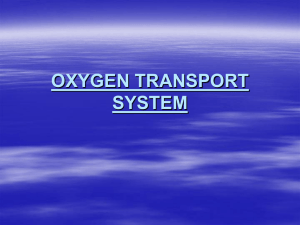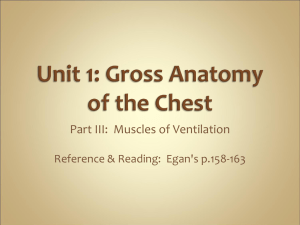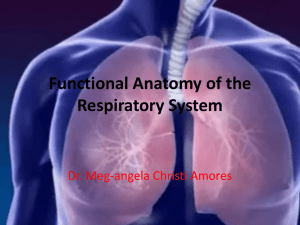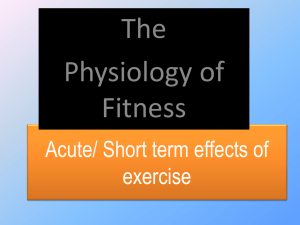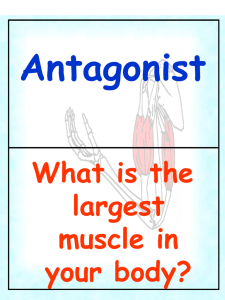2. Mechanics Of Breathing
advertisement
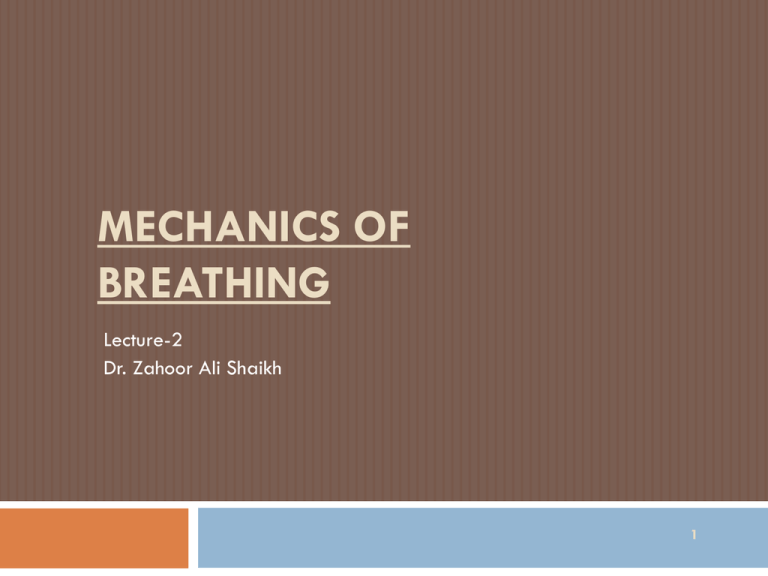
MECHANICS OF BREATHING Lecture-2 Dr. Zahoor Ali Shaikh 1 Mechanics Of Breathing 1. Inspiratory Muscles 1. Diaphragm [major muscle contributes 75%] 2. External Intercostals contribute 25% Diaphragm When Diaphragm contracts [on stimulation of phrenic nerve C3, C4, C5], it descends down and increases vertical diameter of the chest . During quiet breathing, Diaphragm descends about 1cm but during deep inspiration it may descend up to 10cm. 2 Inspiratory Muscles 2. External Intercostals Contraction of these muscles, whose fibers run downward and forward between the adjacent ribs, enlarge the thoracic cavity in lateral [side to side] and anterio-posterior [front to back] dimensions. When external intercostal muscle contracts, they elevate the ribs and the sternum upward and outward. Intercostal nerves activate these intercostal muscles. 3 4 Inspiration Before Inspiration, intra-alveolar pressure is equal to atmospheric pressure (760mmHg) so no air is flowing into or out of lungs. As the thoracic cavity enlarges [due to contraction Inspiratory muscles] the lungs also expand to fill the large thoracic cavity. As the lungs enlarge, the intra-alveolar pressure drops by 1mmHg to 759mmHg, therefore, air flows inside, down the pressure gradient from higher atmospheric pressure to lower pressure. 5 Inspiration Air enters the lungs till pressure equalizes [atmospheric and alveolar]. Note : Air flows into the lungs because of fall in the intra-alveolar pressure brought about by lung expansion due to enlargement of thoracic cavity due to contraction of inspiratory muscles. 6 Intra-pleural Pressure during Inspiration During Inspiration, the intra-pleural pressure falls to 754mmHg [-6mmHg], as a result of expansion of the thorax. Please note – Intra-pleural pressure before inspiration is 756mmHg [-4mmHg]. 7 8 9 Accessory Muscles Of Inspiration Forceful or deep inspiration can be brought about by contraction of accessory muscles of inspiration. They work with diaphragm and external-intercostal. Accessory Inspiratory Muscles Are: - Sternocleidomastoid - Scalenus - Trapizus - Pectoralis major 10 Accessory Muscles Of Inspiration Contraction of Accessory muscles causes lifting of sternum and elevation of first two ribs, enlarging the upper portion of thoracic cavity. As the thoracic cavity increases even further, lungs expand more, dropping intra-alveolar pressure further. Therefore, more inward flow of air occurs. 11 Expiration Expiration is passive process. It occurs due to the relaxation of Inspiratory muscles i.e. diaphragm and external-intercostal muscle. As diaphragm and external-intercostal muscle relax, the chest wall and stretched lungs recoil to their original [pre-Inspiratory] size, due to their elastic properties. As the lungs recoil and become smaller in size, the intra-alveolar pressure rises by 1mmHg [761mmHg]. 12 Expiration As intra-alveolar pressure increases, air leaves the lungs down its pressure gradient from high intraalveolar pressure to lower atmospheric pressure. Air flow stops when intra-alveolar pressure becomes equal to atmospheric pressure. 13 Muscles of Forced Expiration Muscles of forced [active] expiration are: - Internal-intercostal muscles - Abdominal muscles [rectus abdominas, transverse abdominas ,external oblique, internal oblique] NOTE During quiet breathing, expiration is passive process. It occurs due to relaxing of inspiratory muscles. Forceful expiration which is active process, we need contraction of forced expiratory muscles. 14 Muscles of Forced Expiration Contraction of abdominal muscles decrease the vertical diameter of thorax. Contraction of internal-intercostal muscles pull the ribs downward and inward, flattening the chest wall and decreasing the size of thoracic cavity [this action is opposite of external-intercostal muscles which pull the chest upward and outward]. 15 Muscles of Forced Expiration Contraction of expiratory muscles decreases the volume of thoracic cavity, lung volume decreases, intra-alveolar pressure increases, therefore, air leave the lung. Lungs are emptied more during forceful expiration [during active expiration as compared to passive expiration]. 16 17 Summary of Inspiration & Expiration Normal Inspiration is active process due to contraction of diaphragm and external-intercostal muscles. Normal Expiration is passive process due to relaxation of diaphragm and external-intercostal muscles. Forceful inspiration - we use accessory muscles of inspiration e.g. sternomastoid, sclene etc. Forceful expiration – we use accessory muscles of expiration e.g. internal-intercostal and abdominal muscles. 18 18 Clinical Application Inspiratory muscles Diaphragm which contributes to 75%, if paralyzed due to nerve damage or muscle disorder, it leads to severe respiratory impairment. External-intercostal which contribute to 25%, if paralyzed, it does not seriously affect the breathing. 20 Air way resistance affects Air flow Air flow depends on the resistance offered by air ways (bronchi and bronchioles). Resistance will increase if the radius of conducting air ways (bronchi) gets smaller. Air ways are supplied by Autonomic Nervous System [ANS]. Parasympathetic ANS – causes broncho-constriction (decreases the radius of bronchioles) therefore increases the air way resistance. Sympathetic ANS and Epinephrine They cause broncho-dilation (increase the radius of bronchioles) therefore decrease the air way resistance. 21 Air way resistance Nowadays new drugs e.g. ventolin which act on β2 receptors which are present in bronchi (air ways) cause broncho-dilation. They are commonly used for Bronchial Asthma. 22 Clinical Application Chronic Obstructive Pulmonary Disease [COPD] In COPD, there is increased air way resistance due to narrowing of lumen of lower air ways. Patient with COPD have difficulty in breathing. COPD applies to 3 diseases: 1. Chronic-Bronchitis 2. Bronchial Asthma 3. Emphysema 23 Chronic-Bronchitis Affects lower respiratory airways. It is triggered and ppt by cigarette smoking, polluted air and allergens. Due to chronic irritation – air way is narrowed due to thickening of its lining, cilia lining the airways are also affected, therefore, mucus can not be removed satisfactorily. Pulmonary Bacterial Infection are common. 24 Bronchial Asthma Air way obstruction occurs due to - thickening of airway walls due to inflammation. - increased secretion of mucus. - airway constriction [spasm of smooth muscle in walls of airways] due to exposure to dust, pollen, cigarette smoking, infection, severe exercise. - increased airway resistance causes more difficulty during expiration than inspiration, causing wheeze. 25 Emphysema Emphysema is characterized by - collapse of small airways - breakdown of alveolar walls - increased airway resistance Emphysema is irreversible condition. Emphysema can occur due to chronic exposure to irritants e.g. cigarette smoking due to release of enzyme trypsin released from alveolar macrophages. This enzyme trypsin causes destruction of lung tissue. 26 What You Should Know From This Lecture Muscles of Inspiration [Diaphragm and External-intercostal] and their function. Muscles of Forced Inspiration [Accessory Muscles]. Normal Expiration is passive process. Muscles of Forced Expiration [Accessory Muscles] Atmospheric Pressure, Intra-Alveolar Pressure, Intra-Pleural Pressure. Airway Resistance. Effect of Parasympathetic ANS and sympathetic ANS on airways [bronchi and bronchioles]. Effect of ventolin on airways. Chronic Obstructive Pulmonary [Lung] Diseases. - Chronic-Bronchitis, Bronchial Asthma, Emphysema. 27 THANK YOU 28


